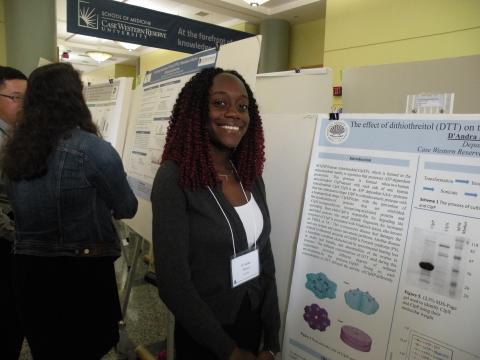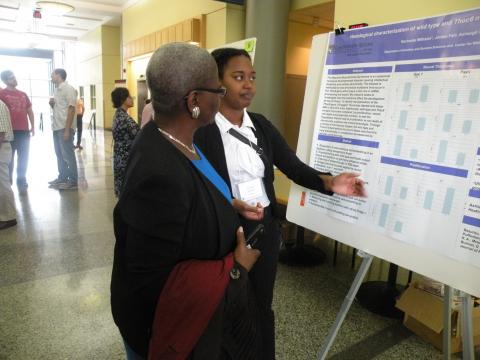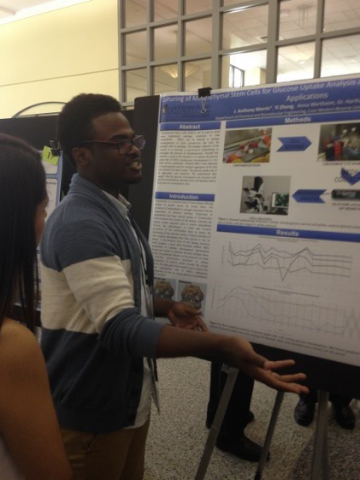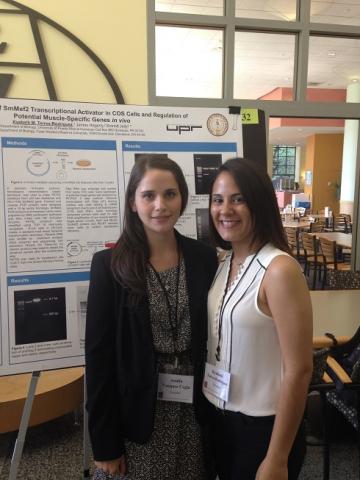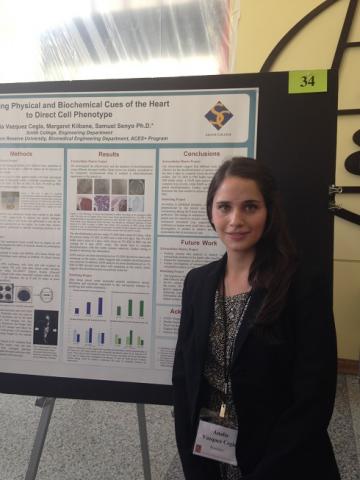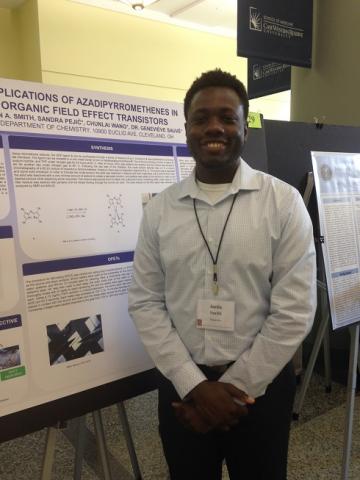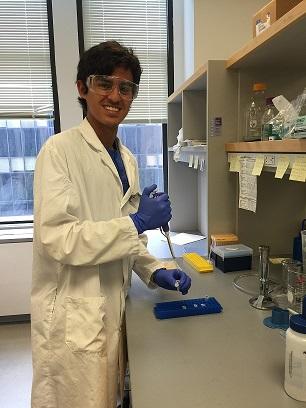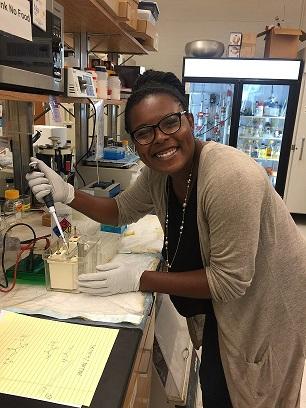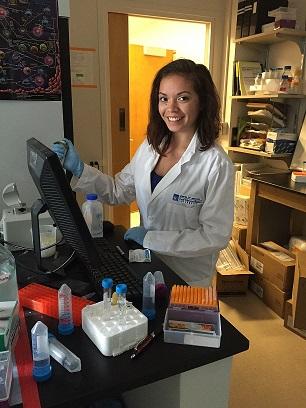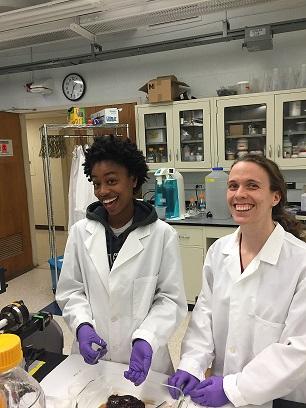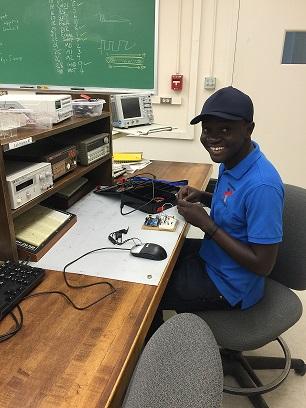2017
D'Andra Moxey
Jahmel Fowler
Experience about program:
The ACES SURP program fortified my knowledge that was gained throughout my tenure at Fisk University. It allowed me to get better understanding of things learned in the classroom. It was an invaluable experience with invaluable people.
Rachanté Williams
2016
Jerome Morris
Attending school: Fisk University
Major: Chemistry and Chemical Engineering
Future Plans: Ph. D. in Chemistry and Biomedical Engineering
Jerome Morris is interested in pursuing an additional research experience next year. He will also begin to research graduate schools. His passion lies in teaching and helping others.
Poster Abstract:
Mesenchymal Stem Cells (MSCs) can be used to create tissue engineered cartilage constructs to treat osteoarthritis. MSCs can be induced to undergo chondrogenesis to form chondrocyte like cells, the principal cells in cartilage. The strategic objective of this research is to develop a non-invasive methodology to interrogate the process of chondrogenesis. Towards this objective, a goal of the research is to analyze the glucose uptake rate of MSCs undergoing chondrogenesis in vitro under various conditions. Cultured MSCs were subjected to chondrogenesis and the resultant aggregates of the cells were cultured for three weeks. The glucose uptake rate of the aggregates was analyzed. The data suggests that the glucose uptake rate increased in greater glucose concentrations and greater cell densities.
Experience about program:
The ACES+ Summer Undergraduate Research Program at Case Western Reserve University (CWRU) allowed me to work with Dr. Harihara Baskaran in the Department of Chemical and Biomolecular Engineering as a biomedical engineer undergraduate researcher. My lab and I induced cell growth in human mesenchymal stem cells (hMSC) to develop a non-invasive methodology to interrogate the process of chondrogenesis. My research project primarily focused on the analysis of metabolic rate of hMSCs undergoing growth process in vitro under varying glucose concentrations and cell densities. Outside the laboratory provided many memorable moments with other CWRU students, summer interns from other universities, and events in the heart of Cleveland, OH. Dr. Heather Burton and Chalana Gilliham, our summer program coordinators, were especially welcoming and kind. They made my summer in Cleveland even greater than anticipated. My experiences at CWRU, along with career advice I had received from Dr. Burton, has now positioned me as a select few contending for an internship in Sunnyvale, CA as an Apple HBCU scholar chemical engineer undergraduate intern in Apple’s Manufacturing Design Department. I am very grateful for the ACES+ program as I have gained a wealth of knowledge, friendships (persons I now talk to everyday), and network over the course of one summer.
Kyabeth Torres-Rodriguez
Attending school: University of Puerto Rico-Humacao
Major: Microbiology
Future Plans: To Obtain a Ph. D.
Kyabeth Rodriguez is interested in taking a year off from college to travel and assist in helping underprivileged communities. She would then like to attend graduate school. She is considering graduate studies right after school and research on socioeconomic disadvantaged communities.
Poster Abstract:
Myocyte enhancer factor 2 (Mef2) is a transcriptional activator that is expressed in muscle cells promoting myogenesis. The Mef2 protein is highly conserved and is a member of the MADS-box family of proteins that encode for transcription factors that regulate gene expression. In many organisms, Mef2 is critical for cellular differentiation, embryonic development and survival. Our lab identified and initially characterized schistosome Mef2 (SmMef2), however, the complex life cycle of schistosomes makes an in depth understanding of basic developmental mechanism challenging. Schistosomes are the disease-causing agents of Schistosomiasis, the most important neglected parasitic disease after malaria according to the World Health Organization. There are approximately 200 million people infected worldwide. Schistosomes penetrate mammalian skin to invade the circulation and other crucial organs in which they complete their life cycle. In the hope to expand our knowledge about schistosome early muscle developmental pathways and to circumvent the challenges of genetic manipulation of these previously intractable parasites, we wanted to examine the expression profile of SmMef2. Plasmid PKT02 was designed in order to introduce strong and stable Mef2 expression. Genetic manipulation of schistosome material is difficult and material is limited. To alleviate this, we will assess the effect of Mef2 misexpression in on its target genes in Green Monkey Kidney cells (COS-7 cells). We hypothesized that the evolutionary distant SmMef2 muscle-specific gene regulator from schistosomes will promote initial expression of myocyte specific genes in COS-7 cells.
Experience about program:
The ACES+ summer research program gave me the opportunity to gain hands-on experience and found relationships that will help me in my future career. I gained great lab (and life) mentors, new friends and lifelong skills.
Analia Vazquez
Attending school: Smith College
Major: Engineering Science
Future Plans:
Analia Vazquez is interested in pursuing graduate studies in Biomedical Engineering. She wants to work as a researcher to find innovative solutions to health related problems.
Experience about program:
The ACES+ Program gave me the opportunity to get involved on my first research experience. This outstanding summer research program helped me gain a better understanding of the field I would like to work on in the future, which is the field of Biomedical Engineering. While investigating the effects of mechanical forces on cell behavior, I gained valuable knowledge about lab techniques such as cell culture and fluorescent imaging. With help from my faculty adviser, Sam Senyo PhD, I learned how to plan experiment timelines, read primary literature, and write a scientific poster. The final poster presentation helped me improve my communication skills and my confidence as a scientist. Outside working hours, I had a great time sharing fun activities such with other students from the program and exploring the beautiful city of Cleveland. We had the opportunity to experience the joy of the Cavs winning the NBA finals, watching a play on Playhouse Square, and riding great roller coasters on Cedar Point. Besides helping me become a more competitive candidate for graduate school, the ACES+ program allowed me establish long-life connections and friendships. This was a great summer experience!
Justin Smith
Attending school: Fisk University
Major: Chemistry
Future Plans: To obtain a Ph. D. in Chemical Engineering
Research Experience abstract:
A transistor is a semiconducting device that is used to amplify or switch electronic signals and electrical power. An organic field-effect transistor (OFET) uses an electric field applied by a terminal (the gate) to control the electric conductivity of a channel of one type of charge carrier in an organic semiconductor. In recent studies, azadipyrromethene (ADP) and its derivatives have emerged as a class of compound with highly desirable and near-infrared photo-physical properties. Thus, this current study serves to investigate the application of Zn(ADP) 2 as an organic semiconducting layers in a top-contact bottom-gate organic field effect transistor.
Experience about program:
The program was a great learning experience. I gained invaluable lab skills and life skills by interacting with mentors and current students.
2015
Jean Carlos Fernandez Gonzalez
Attending school: University of Puerto Rico Rio Piedras
Major: Molecular Biology
Mentor: Derek Taylor, Associate Professor, Department of Pharmacology, School of Medicine
Poster abstract: Determining ssDNA binding specificities of POT1, POT1-TPP1, and RPA1 through HiTS-EQ data analysis
Jean C. Fernandez Gonzalez; Department of Molecular Biology (UPRRP), Maria de la Fuente; Department of Pharmacology, Malligarjunan Rajavel; Department of Pharmacology, Hsuan-Chun Lin; Department of Biochemistry, Michael Harris; Department of Biochemistry, and Derek Taylor; Department of Pharmacology
POT1 is a protein that binds to telomeric single-stranded DNA (ssDNA) and it is part of the telomere sheltering complex, along with five other proteins, which prevent telomeres from being recognized as DNA breaks and triggering DNA damage response. POT1 forms a stable complex, with another protein of the telomere sheltering complex, called TPP1. The binding of POT1 to ssDNA is enhanced by TPP1. Replication Protein A (RPA) is an ssDNA binding protein. RPA is known to be essential for chromosomal DNA repair, replication and recombination. In this project we a 6N oligo and analyzed HiTS-EQ data from POT1 and POT1-TTP1, to obtain binding affinities for 4096 distinct ssDNA sequences. The different affinities were used to determine ssDNA binding specificity of POT1 and POT1-TPP1. Results showed that POT1-TPP1 binds with more affinity to ssDNA than POT1. Also, results reveal that POT1 and POT1-TPP1 have a strong preference for binding a T at the second position of the 6N oligo. We intended to obtain HiTS-EQ data from RPA1 using 8N loop oligos, to compare it with the POT1 and POT1-TPP1 data obtained. In order to do so, RPA1 was cloned, expressed and purified. Gel shifts were performed with different ssDNA sequences to test RPA1 binding. Our results showed that RPA was bound to every ssDNA sequence tested. Thus, to obtain accurate HiTS-EQ data of RPA1, an 8N loop oligo was designed and gel shifts were performed. RPA1 + 8N loop Gel shifts showed multiple undefined bands. Suggesting that multiple RPA1 were binding to the 8N loop oligo at the loops or that RPA1 was destabilizing dsDNA regions of the 8N loop and unfolding it.
Experience about program:
In the summer I had Dr. Derek Taylor as my mentor. I worked with him in the department of pharmacology (Medical school). The research I worked on allowed me to put in practice most of the knowledge obtained from my biology and chemistry courses. In addition, it gave me the opportunity to learn new biochemical techniques used in the laboratory like: PCR, Cloning, Protein purification (affinity column chromatography and size exclusion chromatography), sequencing, Protein characterization, and data analysis. Apart from the lab techniques, I learned how to do a poster, which is very important in order to develop scientific writing, communicating, and critical analysis skills. Finally in the lab I met and worked with a diverse group of people, from which I learned allot. Therefore I can say that the research experience was great.
My program coordinators were Jennifer Jackson and Chalana Ghilliham. They were very nice and friendly. Both helped out if I needed anything during the summer program. Also they were always making sure that everything was good with my research and mentor. Both worked very hard on planning different activities to have fun in the summer (Niagara Falls, Cedar Point, River Boat ride). Also, they scheduled several different workshops for program students. I could not have asked for better coordinators than Jennifer and Chalana. Both of them worked really hard to make sure we had the best summer undergraduate research program experience possible. Apart from my program coordinators I have to say that the program benefits like the Case Cash and Flight arrangements were nice. The stipend was really good and the dorms (The Village) were amazing.
The overall summer undergraduate research experience form the ACES+ program was incredible. It gave me the opportunity to network and allowed me to develop new laboratory and communicating skills. The experience permitted me to grow professionally and academically. I will never forget such a fun and enriching experience.
Carleigh Frazier
Attending school: Fisk University
Major: Biology
Mentor: Gregory Tochtrop, Associate Professor Biochemistry, College of Arts and Sciences / Elizabeth Stewart
Poster abstract: Investigating Synthesized Fatty Acids as Inhibitory Compounds for the Human Fatty Acid Binding Protein 5 (hFABP5)
Retinoic Acid (RA) has been shown to promote cell arrest in certain types of cancer, while in other types, RA promotes cell growth and proliferation. These dual outcomes are caused by two alternate receptor pathways in the cancerous cell. RA is shuttled to the nuclear receptors that lead to growth or arrest by carrier proteins. Cell growth is facilitated by the human fatty acid binding protein 5 (hFABP5) which is an intracellular lipid binding protein. By inhibiting hFABP5 in cancerous cells, RA can be shuttled to the cell arrest pathway, stopping tumor growth. After growing and purifying hFABP5, synthesized fatty acids are used in a competitive binding assay to quantify the affinity of the compound to the protein using the inhibitory constant, Ki. Using the data obtained, a viable compound can be identified to enhance the use of RA as a cancer treatment in more cancer cell types through the inhibition of hFABP5.
Experience about program:
Attending the ACES+ Summer Undergraduate Research Program at Case Western Reserve University was an amazing experience! While working under my graduate student, I gained so much experience in working in a lab and mastering various lab techniques. However there was a great balance of work and play, and the program encourages participants to explore the great city of Cleveland! My summer at ACES+ was one of the best summer experiences that I’ve ever had!
Alyssa Lopez
Attending school: University of Illinois at Chicago
Major: Bioengineering
Mentor: Nicole Steinmetz, Assistant Professor, Biochemistry, Case School of Engineering
Poster abstract: Plant Viral Nanoparticles for Cancer Therapy Applications
Alyssa Lopez, Department of Bioengineering; Anna E. Czapar, Department of Pathology; Nicole F. Steinmetz, Department of Biomedical Engineering, Radiology, Material Science and Engineering, Macromolecular Science and Engineering
Nanotechnology is an emerging field with many important applications for drug delivery, imaging, and immune modulation. While many synthetic nanoparticles have been developed, viral nanoparticles (VNPs) offer unique advantages. VNPs are noteworthy because they are naturally monodisperse, exceptionally stable, and biocompatible.1 Further, use of VNPs derived from plant viruses ensures that these nanoparticles will not be infectious to humans or other animals. This project examines the use of two such plant viruses: tobacco mosaic virus (TMV) and cowpea mosaic virus (CPMV). Both viruses have distinct characteristics and advantages. Among them include their size and shape. TMV is rod-shaped and measures to be 300 x 18 nm while CPMV is icosahedral and measures to be 30 nm. Current work focuses on using TMV as a carrier for a newly developed cisplatin derivative that has been shown to be effective against cancer cell lines which are resistant to standard-of-care platinum chemotherapeutics. Through in vitro experiments using ovarian cancer cells, potency of this drug has been compared to traditional platinum anticancer drugs. Free drug as well as TMV-encapsulated drug delivery was studied. In addition to using TMV as a nanocarrier, we have also begun the development of CPMV carriers for drug delivery. Toward this goal, we investigated ways to remove RNA from CPMV. This process is important, because the removal of the RNA increases the total internal volume of CPMV and reduces non-desired RNA-drug interactions. With these results, we hope to move forward with in vivo experimentation with a final goal of human cancer therapy.
Project Mentor: Anna Czapar, Department of Pathology
Faculty Sponsor: Nicole F. Steinmetz, Department of Biomedical Engineering, Radiology, Material Science and Engineering, Macromolecular Science and Engineering
Experience about program:
The ACES+ Summer Undergraduate Research Program was not only my introduction into the research world, but also an opportunity for me to branch out and form new connections with those in a broad range of fields. This summer, I was able to take my first step into the future I wish to pursue. I learned a multitude of lab techniques and became familiar with the atmosphere of a research laboratory. It gave me assurance that this is what I want to do. Aside from research, I was also able to explore Cleveland with the friends I made in the program and in the lab. The area surrounding Case Western Reserve University has a rich culture with its multitude of museums and greenery, and Cleveland itself is full of beautiful sites. ACES+ made sure that there was an equal amount of “fun” time to balance out the immense workload that we were tasked to complete in the very short ten weeks that we were there. Overall, it was a worthwhile summer and I would recommend this program to anyone who is interested in the research world.
Maya Mason
Attending school: Vanderbilt University
Major: Biomedical Engineering
Mentor: Ozan Akkus, Professor, Mechanical and Aerospace Engineering, Case School of Engineering
Poster Abstract:
Comparison of Collagen Extraction Techniques on the Aplysia californica Sea Hare
Collagen is a fibrous protein found abundantly in skin, bone, and as such, can be readily extracted from any of these structures from any species. This study compared several methods of collagen extraction on several organs of the Aplysia californica; specifically, the mantle, gizzard, and skin. Although collagen is insoluble under normal physiological conditions, fractions of collagen can be extracted using acid and pepsin, an enzyme found in stomach acid. The extraction methods tested were acid-only, pepsin-only, and a combination of acid and pepsin. The acid-only procedure used acetic acid to extract acid-soluble collagen. The pepsin-only procedure extracted pepsin-soluble collagen. The combination procedure extracted both the acid-soluble and pepsin-soluble collagen. The study also investigated the purity and compactibility of the extracted collagen. Purity was tested by performing a dimethyl methylene blue (DMMB) assay that measured the amount of extracellular sugars present in the collagen. Compactibility was determined using the electrocompaction method, in which a voltage is applied to a collagen gel in order to align the molecules within it to make a compact, strong structure. Compacted collagen contains fibers that can be aligned via stretching mechanisms. These aligned fibers allow for various types of cell differentiation. For example, skeletal muscles seeded onto aligned collagen differentiate into myotubes. Future directions for this project include cultivating myotubes by seeding Aplysia californica skeletal muscle cells on sheets made from the extracted collagen, and then stimulating the myotubes with cultured neurons.
Experience about program:
Participating in the ACES+ program has made me a competitive candidate for graduate school. The immersive aspects of the program, both in research and professionalism, have aided me in my personal development. My mentor, Dr.Akkus, had high expectations for my research involvement, work ethic, and lab participation. However, the graduate students that I worked with helped me meet and exceed his standards. In working with Katherine Chapin, a Master’s candidate, I learned about technology transfer between academic research and medical technology companies. From Vickie Webster, a PhD candidate, I learned about the preliminary research being done concerning biomimetic collagen structures and their possible applications. My experience over the summer shaped my decision to apply to graduate programs offering hands-on experience in identifying clinical needs and developing feasible and economic solutions to these problems. The ACES+ Summer Undergraduate Research Program is a priceless experience and I am grateful that I was able to be a part of it.
Ebenezer Nkrumah
Attending school: Fisk University
Major: Physics/Mathematics
Mentor: Kathleen Kash, Department Chair and Professor of Physics, College of Arts and Sciences
Poster abstract: INTERFACING THE SPEX 1404 DOUBLE SPECTROMETER WITH AN ARDUINO
Ebenezer Nkrumah, Physics Department; Glynis Schumacher, Physics Department; and Kathleen Kash, Physics Department
Raman spectroscopy is a technique used to observe vibrational, rotational, and other low-frequency modes in a system. Raman spectroscopy is commonly used in chemistry to provide a fingerprint by which molecules can be identified and it commonly used by research Physicists to identify energies of phonon modes of crystals. Our lab uses the Spex 1404 double spectrometer to do Raman spectroscopy. Unfortunately, the original interface of the Spex 1404 is outdated and not functional for our lab needs, being around 3 decades old. The goal of this project is to interface the spectrometer with computer control via an Arduino and take readings using a Matlab script. We use the Arduino Uno to send digital signals to the stepper motor which is connected to the spectrometer, and receive analogue signals on our computer from the Arduino Uno as feedback. A prototype model which simulates the actual procedure was built using an LED and a photocell. The success of this project will allow us once again to use the highly sensitive and precise SPEX 1404 spectrometer with easier, interactive and modern experimental procedures.
Project Mentor: Professor Kathleen Kash; Physics Department
Experience about program:
The ACES+ program gave me an empowering experience. It provided a much a needed platform to lift me up both academically, intellectually and personally. Being a learner without having a career focus, the summer project I was assigned to, made me discover my love and passion for computers, programming and robots. Also, lunch and learn meetings organized weekly throughout the summer introduced us to a diverse range of educational topics and helped build on former expertise. The coordinators (Chalana and Jennifer) were quick at hand to make us feel as comfortable as possible and I always enjoyed checking in with them to “bug” them. There were fun moments too as we went on a couple of trips to get a break from our summer projects. Overall, the ACES+ program gave me the most meaningful summer experience of my life so far and I would recommended that every student to apple to partake in the it.


